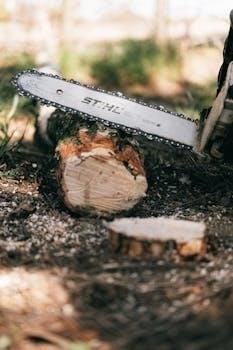Chainsaw sawmill guides are essential tools for transforming logs into lumber. These attachments facilitate precise, controlled cuts using a chainsaw. They enhance a chainsaw’s versatility, allowing for diverse woodworking projects.
What is a Chainsaw Sawmill?
A chainsaw sawmill, often referred to as a portable sawmill or chainsaw mill, is a specialized attachment that transforms a standard chainsaw into a lumber-making machine. It essentially provides a guided framework for the chainsaw, allowing it to make straight and consistent cuts through logs, converting them into usable boards or beams. Unlike traditional sawmills, these attachments are designed for portability and are ideal for processing timber in remote locations or on-site where larger machinery isn’t feasible. They facilitate a range of tasks from creating lumber and beams to flattening log surfaces. These attachments can be bolted onto various chainsaw models, utilizing the chainsaw’s power for cutting. The core principle of a chainsaw sawmill involves securing the chainsaw to a frame or guide system, ensuring that each cut is uniform and precise.
Types of Chainsaw Mill Attachments
Chainsaw mill attachments come in various designs, each tailored for specific cutting tasks and user preferences. The most common type is the Alaskan mill, which features a frame that clamps onto the chainsaw bar and guides it along a log, allowing for parallel cuts to create slabs. Another type includes smaller, more portable attachments, often used for cutting beams or flattening log surfaces. There are also specialized attachments for creating custom cuts, such as those required for log walls or rafters. Some attachments are designed for specific chainsaw models, while others offer universal compatibility. The materials used in construction vary, with aluminum and steel being popular choices for durability and stability. The selection of a suitable attachment depends on the desired cutting results, the size of the logs being processed, and the chainsaw’s capabilities.

Essential Features of a Chainsaw Mill Guide
A crucial feature is robust construction, ensuring stability during milling. Adjustable components are essential for accurate cuts. The guide should also offer ease of use and secure attachment.
Stability and Construction
The stability and construction of a chainsaw mill guide are paramount for achieving accurate and safe milling operations. A robust build, often featuring materials like aluminum or steel, is crucial to withstand the vibrations and stresses of cutting logs. The guide’s frame should be rigid, minimizing flex and ensuring consistent cutting depth. Components like anti-loose nuts and large washers contribute to this stability, preventing the guide from shifting during use. Black oxide coatings on components provide added durability and protection against corrosion. The design should focus on a secure attachment to the chainsaw bar, typically requiring drilling for a solid connection. Such a stable platform is essential for the consistent and precise movement needed to produce high-quality lumber. A well-constructed guide will reduce the risk of accidents and improve the overall efficiency of the milling process. Ultimately, stability and robust construction are the cornerstones of a reliable chainsaw mill guide.
Adjustability and Cutting Precision
Adjustability is a key feature of a quality chainsaw mill guide, enabling users to achieve precise cuts for various lumber dimensions. The ability to easily adjust the cutting depth and width is critical for producing boards of consistent thickness. This adjustability often involves scales and locking mechanisms that allow for fine-tuning and secure settings. Cutting precision relies heavily on the guide’s ability to maintain a straight and consistent path along the log. A well-designed guide will minimize movement and ensure that the chainsaw cuts uniformly, resulting in smooth and accurate boards. The guide should also facilitate even cuts, preventing the saw from digging in or wandering off course. High-quality materials and construction contribute to this precision by minimizing play and vibration. This adjustability is essential for producing high-quality, usable lumber. The precision provided by a good mill guide is the difference between rough cuts and accurate boards.

Using a Chainsaw Sawmill Guide
Using a chainsaw mill guide involves proper preparation and technique. This includes securely attaching the guide to the chainsaw and log. The first cut requires patience, and troubleshooting is essential for smooth operation.

Preparing Your Chainsaw and Guide
Before beginning any milling operation, meticulous preparation of both your chainsaw and sawmill guide is crucial for safety and optimal performance. First, ensure your chainsaw is in excellent working condition. This involves checking the chain’s sharpness and tension; a dull or loose chain can lead to inefficient cutting and increased risk of kickback. Inspect the bar for any bends or damage, and ensure it is properly lubricated. Next, carefully attach the chainsaw mill to your chainsaw bar, following the manufacturer’s instructions precisely. Verify that all bolts and connections are securely fastened, paying special attention to the anti-loose nuts. The guide should be stable and aligned correctly with the bar to ensure accurate cuts. It is also vital to verify that the guide’s surface is clean from debris. Finally, before starting the milling process, adjust the guide to the desired thickness of the lumber you intend to cut. This pre-cutting adjustment ensures that the first cut is accurate.
Making the First Cut
Making the first cut with a chainsaw sawmill guide requires careful attention to detail and a steady hand. Begin by positioning the chainsaw and guide on the log, ensuring the guide is firmly resting on the log’s surface. Start the chainsaw, maintaining a firm grip, and gradually engage the chain into the wood. Avoid forcing the cut, let the chainsaw do the work. Move the saw along the guide at a consistent pace, keeping it parallel with the log. This initial cut sets the reference surface for all subsequent cuts. It’s essential to keep the saw level and the guide stable to maintain a uniform thickness of cut. A smooth, steady movement is key for a clean and precise first cut. If you feel any resistance or see that the cut is not going straight, stop immediately, examine the setup, and correct the issue before proceeding. This ensures that your lumber will be of consistent size and quality.
Troubleshooting Common Issues
Encountering problems is not uncommon when using a chainsaw sawmill guide, but most can be resolved with a bit of troubleshooting. One frequent issue is the chainsaw binding or sticking during a cut. This can often be due to a dull chain or improper chain tension. Ensure that the chain is sharp and properly set before starting any milling. Another common issue is uneven cuts, which can be caused by the guide not being level or stable. Always check and double-check the guide’s stability before beginning. If the mill is vibrating excessively, the issue might be loose bolts or components. Always make sure that all parts are securely fastened. Difficulty maintaining a straight line may stem from applying too much or too little force. Maintain a consistent, smooth movement. Sometimes, the wood itself might be causing issues such as hard knots. If these issues persist, it may be time to consult online resources or seek expert advice.

Maintenance and Upgrades
Regular maintenance is key to keeping your chainsaw sawmill guide in top shape. This includes sharpening chains and making adjustments. Upgrades can also improve efficiency and overall performance.
Sharpening and Setting Chains
Maintaining a sharp chainsaw chain is paramount for efficient milling. Dull chains require more force, leading to uneven cuts and increased wear on both the chainsaw and the mill attachment. Sharpening involves using a file or a specialized chain sharpener to restore the cutting edges of each tooth to their correct angle and depth. Setting the chain refers to ensuring that the teeth are aligned and have the correct clearance. A properly sharpened and set chain will reduce the amount of sawdust produced and increase the speed of the cut. This not only saves time but reduces the load on your equipment. Regular checks and adjustments are essential. Consistent maintenance of the cutting chain is essential for safe and effective operation. The process should become part of your regular milling routine for maximum efficiency. Therefore, a well-maintained chain is vital for maximizing the performance of your chainsaw sawmill setup.
Enhancing Mill Performance with Accessories
Various accessories can significantly enhance the performance and versatility of your chainsaw mill. Pintle hook mounts, drawbars, and hitch balls are useful for moving logs and lumber around the workspace. Hitch pins and receiver tubes provide secure connections for your equipment, ensuring safety during operation. Ball mounts and trailer jacks aid in stabilizing and positioning logs. Security chains offer an extra layer of safety when handling heavy materials. Upgrading your mill with these accessories can lead to increased productivity and precision. Consider anti-loose nuts and large washers to increase the stability of the guide. Such small additions can make a big difference in overall performance. These attachments can make the milling process smoother, faster, and safer. Adding a power upgrade can also help you achieve more with less effort. Investing in the right accessories can greatly improve your sawing experience.




